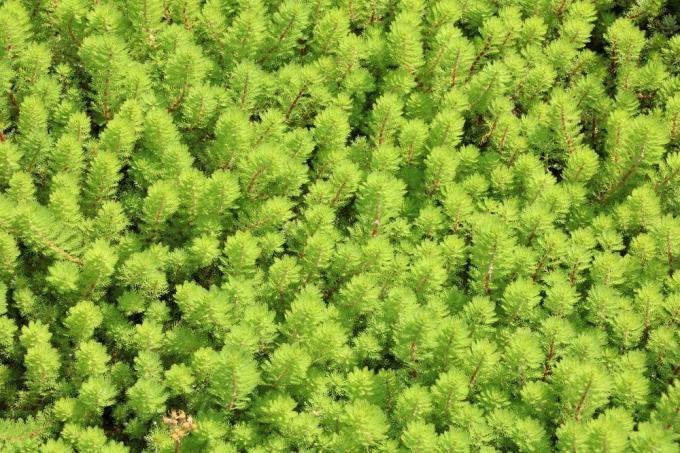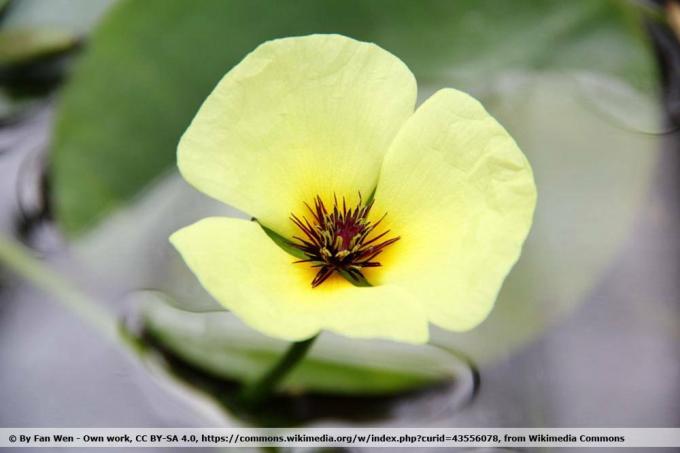
table of contents
- Prepare for winter
- Hibernate 7 pond plants
- Algae fern
- Shell flower
- Thousand-leaf
- Water hyacinth
- Water poppy
- Lotus flower
- Pike herb
Water bodies require special winter preparations, because many pond plants do not survive the frosty temperatures. Tropical plants in particular require mild weather conditions and react sensitively to strong fluctuations in light and temperature. The ideal winter quarters is a room in the basement. Use the preparations to clean the garden pond and bring it into shape.
Prepare for winter
Larger ponds are divided into different zones, which differ in the depth of the water. While bank or swamp zones freeze quickly, temperatures above freezing point prevail in the sufficiently low central area. Plants in the border area and floating plants floating freely on the water surface must be overwintered in a frost-free place. In many cases, plants in the deep water zone can remain in the water as long as they are not frost-sensitive species. Regardless of your body of water, you can follow these instructions:
- Clean the vessels, fill them with substrate and pour water
- Remove floating plants from the water surface
- Lift plant baskets with fragile species out of the water
- Drain water from the pond
- Carefully dig up rooting aquatic plants
- Control aquatic plants
- Remove rotten parts of the plant to prevent disease
Hibernate 7 pond plants
Algae fern
These herbaceous plants belong to the swimming fern family. They develop a dense carpet of leaves that covers the surface of the water. Their finely branched root system floats freely in the water and does not anchor in the substrate. As a result, the tropical plants are endangered in winter when the water surface freezes. Take the algae fern (Azolla spec.) Out of the water in autumn as soon as the temperatures drop towards zero. Then place the plants on the surface of the water in a sufficiently large aquarium. The wintering takes place in a frost-free place in the cellar. Pay attention to the following conditions in the wintering quarters:
- Keep the water temperature at least 20 ° C
- bright location at a window
- Room temperature should be between 15 and 18 ° C

Shell flower
The tropical plants are placed on the surface of the water as floating plants. Long roots that extend deep into the water develop beneath the rosette-shaped leaves. Pistia stratiotes are based on the size of the water and can reach a diameter of up to 30 centimeters. In smaller ponds, however, the leaf rosettes grow less lush. In addition to the coordinated size of the wintering container, you should pay attention to the following factors:
- Avoid dripping wet and dry air so that leaves do not wither
- The water temperature should be between 20 and 25 ° C
- pay attention to freshwater conditions
- pH between 6.5 and 7.2
- Do not cover the receptacle to prevent heat build-up
Before planting the plants, cover the bottom of the container with clay and fill up with water. As soon as the thermometer drops below 15 ° C in autumn, use a net to get the plants out of the pond. The plants are adapted to constant temperatures all year round and do not tolerate large fluctuations. Put smaller aquatic plants in an aquarium to overwinter. Larger specimens need a tub or tub with sufficient water depth so that the roots can develop freely.
Thousand-leaf
Within this genus there are native and tropical species that can easily overwinter in sufficiently deep waters. If there is a risk that the pond will freeze to the ground, you should use Myriophyllum spec. get out of the water and overwinter frost-free. This also applies to thousand-leaf species that grow in mini ponds on balconies or patios. Such biotopes are defenselessly exposed to frost in winter, so that the plants have no chance of survival. These aspects should be taken into account in winter quarters:
- Room temperatures between five and 10 ° C
- Growth is stopped under cold water conditions
- Winter quarters shouldn't be too dark
Dig the plants and their roots out of the substrate. Caution is advised when removing it, because the delicate shoot axes break through quickly. Grasp the plant by the base and support long shoots with the palm of your hand. Then place the plants in a container filled with water and lightly press the roots into the ground.

Water hyacinth
Depending on the outside temperature, the South American aquatic plants thrive in the garden pond between May and October. They swim with their inflated shoots on the surface of the water and develop floating roots. Water hyacinths (Eichhornia crassipes) are brought into the cellar early. The pond plants need:
- Room and water temperatures of at least 15 ° C
- twelve hours of light a day
- a light source above the vessel
- regular ventilation
- fertilization
Use a sheet metal tub for larger stocks. However, individual water hyacinths can also be overwintered in a tall glass vase. The vessel should be between 30 and 40 centimeters deep. Cover the soil to a height of 20 millimeters with humus garden soil. It does not serve to anchor the plant, but rather improves the nutrient content of the water. Put the plant on the substrate and sink the roots into the ground. The vessel is then filled with water and placed in a suitable location.
Water poppy
Hydrocleys nymphoides is native to Central and South America, where it inhabits stagnant waters. Cultivation in the middle and deep zone of the garden pond is possible. The water poppy can withstand cooler temperatures of up to 12 ° C. Under these conditions the plant stops growing until the thermometer rises well above 18 ° C again. Since it is not hardy, you have to bring the aquatic plant to its winter quarters in autumn:
- Water temperature between 18 and 25 ° C
- lower temperatures do not cause any problems for the plants
- soft water that is as free of lime as possible
- muddy and nutrient-rich subsoil
- make sure there is sufficient lighting
Put Hydrocleys nymphoides in a plant basket before spreading it in the garden pond. This saves you the annual digging. The basket is taken out of the water before winter and placed in a sufficiently large container. A heated aquarium with a cover and a sufficiently large air space is ideal for this. When the water temperature falls below 12 ° C due to evaporation, the plants perish. Open vessels that are placed in the basement are therefore not suitable.
Lotus flower
These exotic plants are popular Pond plantsspreading between water lilies. Although lotus flowers (nelumbo) are considered hardy, they are at risk from frost. In sufficiently deep waters with at least 30 centimeters of water under the ice layer, the plants survive the winter. Otherwise, however, the plant should overwinter frost-free in a cool and dark room in the basement, taking into account the following aspects:
- Room temperature between five and 15 ° C
- Water must not ferment
- Remove decaying parts of the plant and change the water
- Use water with little lime
Get the lotus flowers planted in bowls out of the water and then place them in a tub that is at least 50 centimeters high and wide. Be careful not to dry out the roots. Moisten the substrate regularly with pond water or fill the container with water so that the bowl is submerged.

Pike herb
The blue flowers make the pike herb (Pontederia cordata) an attractive plant for the garden pond. Since the aquatic plants are not hardy, you should overwinter the plants according to our instructions. When you have placed the plants in plant baskets, sink them into the deep water area of your garden pond from the end of October. The water depth should be at least 50 centimeters. Alternatively, you can put the plant basket in a correspondingly high container or hibernate individual plants in an aquarium:
- bright location with draft-free conditions
- the warmer the location, the more light there should be
- Root ball can be planted in potting soil
Cut back the above-ground parts of the plant generously. The substrate must be kept moist but not wet throughout the winter. If you do not have a suitable container available, you can wrap the plants in a thick layer of foliage and store them in a cool and dry place in the basement.




